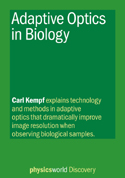Tag archives: microscopy
Adaptive optics in biology
By Matin Durrani
For centuries, astronomers looking up at the heavens through a telescope had a problem on their hands – the quality of their images depended on the strength and direction of the wind in the air. Trouble is, the Earth’s atmosphere isn’t uniform because its density – and thus its refractive index – varies from point to point as the wind blows. Result: distorted images.

Carl Kempf’s new short-form Physics World Discovery ebook is free to read
In 1953, however, astronomer Horace Babcock proposed a clever solution, which was to bounce incoming light off a device that can rapidly correct for changes in optical path-length, which flattens the wave-front and so counteracts the effects of aberration. Any remaining wave-front errors are measured after the correction, before a feedback control loop uses the measurement to continuously adjust the corrections applied to the wave-front.
That was the principle behind “adaptive-optics” technology, which has since gone on to become a routine and invaluable part of astronomy. Turns out, however, that the same principles can be used in microscopy too, leading to many applications of adaptive optics in medicine and biology too, as I’ve discovered by commissioning and editing a new short-form Physics World Discovery ebook by Carl Kempf.
Kempf is a senior systems engineer at the California-based firm Iris AO, Inc, which is heavily into adaptive-optics technology, having worked on sensing, actuation, and control systems for high-precision devices for more than 30 years. I’m pleased to say that Kempf’s short ebook, Adaptive Optics in Biology, is now available for you to read free in EPUB, Kindle and PDF format via this link.
To give you some more idea of what the book is about and his career to date, I put some questions to Kempf, which you can read below. Don’t forget either that there are plenty of other books in the Physics World Discovery series, ranging from multimessenger astronomy to quantitative finance.
View all posts by this author | View this author's profile
Monuments to peer review and Canada, Marie Curie as superhero, a 3D book about Einstein

Cubist sculpture: a monument to peer review. (Courtesy: Igor Chirikov)
By Michael Banks and Hamish Johnston
You may remember a campaign to create a monument dedicated to those hard-working people who peer-review research papers. Last year, sociologist Igor Chirikov, from the National Research University Higher School of Economics in Moscow, raised $2521 on Kickstarter to turn an “ugly” block of concrete outside the university’s Institute of Education into a monument that reads “accept”, “minor changes”, “major changes”, “revise and resubmit” and “reject” on its five visible sides. Well, after months of toil that monument has now been unveiled by Chirikov in a ceremony at the institution that was attended by over 100 supporters. “Most understand the sarcastic nature of the monument and love it,” says Chirikov. “Many also wonder what’s on the bottom side of the monument.” Chirikov is thinking of hanging a small mirror on a nearby tree so that everyone can see “Accept” on the top of the cube.
View all posts by this author | View this author's profile
Probing the quantum nature of water
By James Dacey in Beijing on Friday 4 November
After enjoying clear blue skies for the first couple of days of my visit to Beijing, the breeze has disappeared and the smog has taken its hold. One local scientist told me this latest wave is due to pollution from factories south-west of the city, but others have told me it is difficult to pinpoint a particular source. Facemasks are being worn by every other person in the streets, but fortunately I’ve been sheltered by the walls and ceilings of Peking University (PKU).
View all posts by this author | View this author's profile
Award-winning ‘Bailys Beads’, schoolyard accelerators , pulsar poems and more
By Tushna Commissariat
Its officially that time of the year again when we can marvel at this year’s winners of the Insight Astronomy Photographer of the Year 2016. The awards ceremony, held at the Royal Greenwich Observatory, has unveiled some truly spectacular and ethereal shots of our universe. The overall winner this year is a truly amazing composite image of the 2016 total solar eclipse that shows the ‘Baily’s Beads’ phenomenon and was taken by photographer Yu Jun in Luwuk, Indonesia. In the video above, the judges explain why this particular image was the main winner for the year.
View all posts by this author | View this author's profile
Making noise in the quietest room in the Netherlands

Wiggling electrons: an undulator at one of FELIX’s free-electron lasers.
By Tim Wogan in Nijmegen, the Netherlands
Tucked away near the German border is the Dutch city of Nijmegen and Radboud University, which has a treasure trove of fantastical physics facilities. I was in town for a two-day, whistle-stop tour of the university that included the the opening of the FELIX facility. FELIX stands for “free-electron laser for infrared experiments laboratory”. It is a cavernous chamber housing four free-electron lasers that together can generate high-intensity, tunable radiation with wavelengths anywhere between 3–1500 μm. Something, I was told, that is possible nowhere else in the world.
Web bill-of-rights, cosmic popular culture, origami microscopes and more
By Tushna Commissariat
This week, the Web celebrated its silver anniversary. In March 1989 CERN scientist Tim Berners-Lee proposed a rather contemporary way of linking and sharing information and so the Web was born. There have been numerous stories on the subject this week, but most interesting of all was a Guardian article where Berners-Lee called for the development of an “online Magna Carta” – a bill of rights to enshrine and protect the independence of the Web. “We need a global constitution – a bill of rights,” he said. You can read more about the 25th anniversary at the “World Wide Web Consortium”.
View all posts by this author | View this author's profile